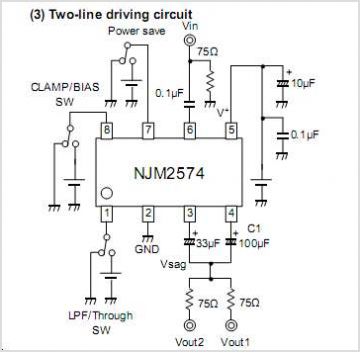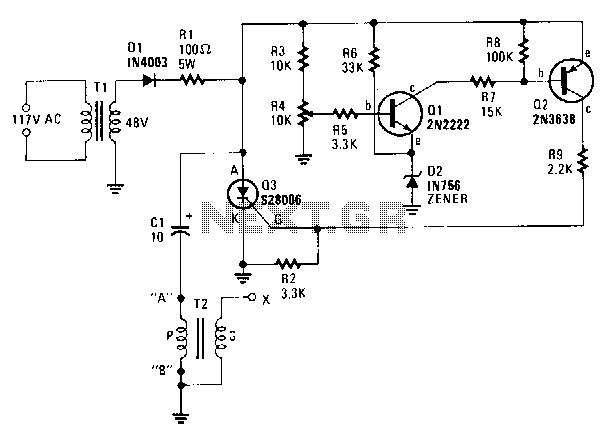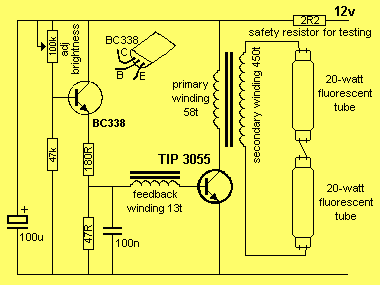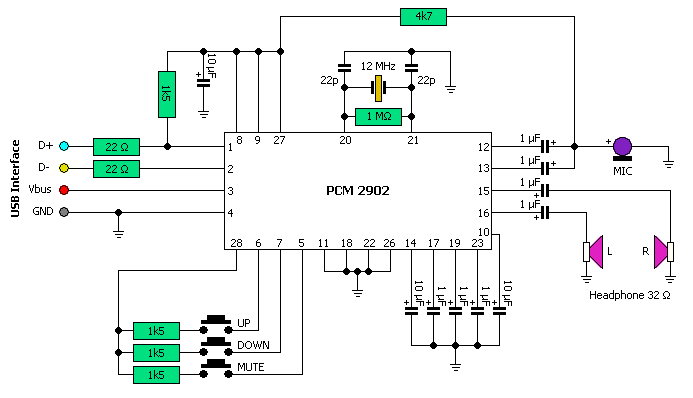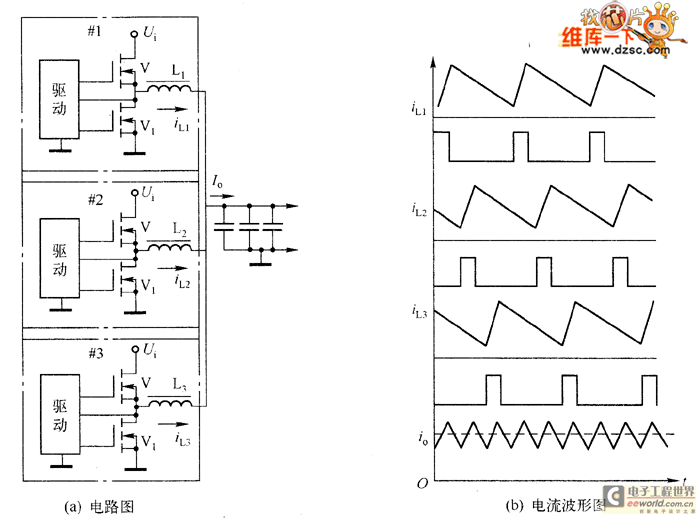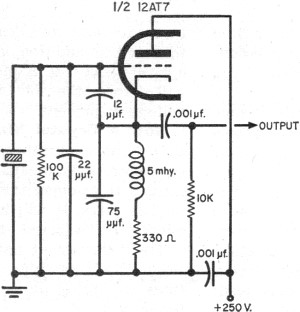
12 Volt Lamp Dimmer schematic

Here is a 12 volt / 2 amp lamp dimmer that can be used to dim a standard 25 watt automobile brake or backup bulb by controlling the duty cycle of an astable 555 timer oscillator. When the wiper of the potentiometer is at the uppermost position, the capacitor will charge quickly through both 1K resistors and the diode, producing a short positive interval and long negative interval which dims the lamp to near darkness. When the potentiometer wiper is at the lowermost position, the capacitor will charge through both 1K resistors and the 50K potentiometer and discharge through the lower 1K resistor, producing a long positive interval and short negative interval which brightens the lamp to near full intensity. The duty cycle of the 200 Hz square wave can be varied from approximately 5% to 95%. The two circuits below illustrate connecting the lamp to either the positive or negative side of the supply.
The circuit described operates on a 12V power supply and is designed to control the brightness of a 25W automotive bulb, commonly used for brake or backup lights. At the core of this dimmer circuit is the 555 timer configured in an astable mode, which generates a continuous square wave output. The frequency of this output is set at approximately 200 Hz, which is suitable for dimming applications as it is fast enough to avoid noticeable flicker in the lamp.
The circuit utilizes two 1K ohm resistors and a variable 50K ohm potentiometer to control the charging and discharging cycles of a capacitor. The charging path for the capacitor varies depending on the position of the potentiometer wiper. When the wiper is positioned at the uppermost end, the capacitor charges rapidly through both 1K resistors and a diode, resulting in a shorter positive pulse and longer negative pulse. This configuration effectively reduces the average power delivered to the lamp, dimming it to a near-dark state.
Conversely, when the potentiometer wiper is at the lowermost position, the capacitor charges through the two 1K resistors and the 50K potentiometer while discharging through the lower 1K resistor. This configuration results in a longer positive pulse and a shorter negative pulse, allowing more power to reach the lamp and brightening it to near full intensity.
The duty cycle of the output square wave can be adjusted anywhere from approximately 5% (minimum brightness) to 95% (maximum brightness), providing a wide range of dimming options. The connection configurations for the lamp allow it to be connected either to the positive or negative side of the power supply, providing flexibility in circuit design and implementation. This dimmer circuit is particularly useful in automotive applications where varying light intensity is required for safety and visibility.Here is a 12 volt / 2 amp lamp dimmer that can be used to dim a standard 25 watt automobile brake or backup bulb by controlling the duty cycle of a astable 555 timer oscillator. When the wiper of the potentiometer is at the uppermost position, the capacitor will charge quickly through both 1K resistors and the diode, producing a short positive interval and long negative interval which dims the lamp to near darkness.
When the potentiometer wiper is at the lowermost position, the capacitor will charge through both 1K resistors and the 50K potentiometer and discharge through the lower 1K resistor, producing a long positive interval and short negative interval which brightens the lamp to near full intensity. The duty cycle of the 200 Hz square wave can be varied from approximately 5% to 95%. The two circuits below illustrate connecting the lamp to either the positive or negative side of the supply.
🔗 External reference
The circuit described operates on a 12V power supply and is designed to control the brightness of a 25W automotive bulb, commonly used for brake or backup lights. At the core of this dimmer circuit is the 555 timer configured in an astable mode, which generates a continuous square wave output. The frequency of this output is set at approximately 200 Hz, which is suitable for dimming applications as it is fast enough to avoid noticeable flicker in the lamp.
The circuit utilizes two 1K ohm resistors and a variable 50K ohm potentiometer to control the charging and discharging cycles of a capacitor. The charging path for the capacitor varies depending on the position of the potentiometer wiper. When the wiper is positioned at the uppermost end, the capacitor charges rapidly through both 1K resistors and a diode, resulting in a shorter positive pulse and longer negative pulse. This configuration effectively reduces the average power delivered to the lamp, dimming it to a near-dark state.
Conversely, when the potentiometer wiper is at the lowermost position, the capacitor charges through the two 1K resistors and the 50K potentiometer while discharging through the lower 1K resistor. This configuration results in a longer positive pulse and a shorter negative pulse, allowing more power to reach the lamp and brightening it to near full intensity.
The duty cycle of the output square wave can be adjusted anywhere from approximately 5% (minimum brightness) to 95% (maximum brightness), providing a wide range of dimming options. The connection configurations for the lamp allow it to be connected either to the positive or negative side of the power supply, providing flexibility in circuit design and implementation. This dimmer circuit is particularly useful in automotive applications where varying light intensity is required for safety and visibility.Here is a 12 volt / 2 amp lamp dimmer that can be used to dim a standard 25 watt automobile brake or backup bulb by controlling the duty cycle of a astable 555 timer oscillator. When the wiper of the potentiometer is at the uppermost position, the capacitor will charge quickly through both 1K resistors and the diode, producing a short positive interval and long negative interval which dims the lamp to near darkness.
When the potentiometer wiper is at the lowermost position, the capacitor will charge through both 1K resistors and the 50K potentiometer and discharge through the lower 1K resistor, producing a long positive interval and short negative interval which brightens the lamp to near full intensity. The duty cycle of the 200 Hz square wave can be varied from approximately 5% to 95%. The two circuits below illustrate connecting the lamp to either the positive or negative side of the supply.
🔗 External reference
Warning: include(partials/cookie-banner.php): Failed to open stream: Permission denied in /var/www/html/nextgr/view-circuit.php on line 713
Warning: include(): Failed opening 'partials/cookie-banner.php' for inclusion (include_path='.:/usr/share/php') in /var/www/html/nextgr/view-circuit.php on line 713
